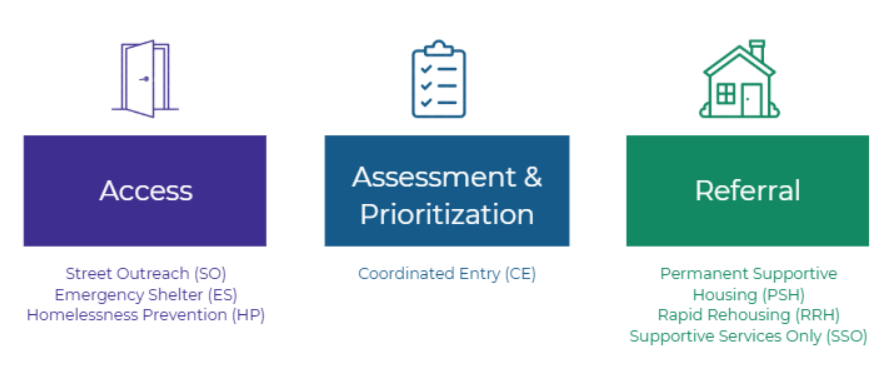Looking for help with HMIS?
HMIS Project Types
In this article, we will review the different project types that will be used in the Homeless Management Information System (HMIS). HUD’s homeless services projects can be organized according to where they operate within the Coordinated Entry (CE) Process.
Introduction
HUD’s grant programs are designed to fund homeless services projects that assist anyone experiencing a housing crisis and/or homelessness. Homeless Services projects in WNY are operated by local organizations. The Coordinated Entry process involves 3 parts: access points, assessment & prioritization ,and referral points.

Things to Know
HUD Definition of Homelessness
Some project types serve different categories of homelessness as defined by HUD. For these project types, it is important to know the four categories of homelessness.
- Literally Homeless
- Imminent Risk of Homelessness
- Homeless under other Federal Statutes
- Fleeing/Attempting to Flee Domestic Violence
For more information on HUD’s definition of homelessness, please see the related article.
Access Points
Emergency Shelter (ES)
HUD-funded Emergency Shelters (ES) provide temporary lodging for members of the community who are facing a housing crisis or fleeing from abusive circumstances. Emergency Shelter teams support their clients through case management, emergency health/mental health services, and by maintaining shelter safety. Emergency Shelter projects being operated in WNY can take three forms:
- Traditional shelters with rooms and/or beds where clients can stay onsite for multiple nights in a row.
- Hotel and motel rooms that are paid for through Emergency Shelter (ES) vouchers provided by the Department of Social Services (DSS).
- Code Blue seasonal shelters are temporary shelters that offer warm beds during the colder months. These shelters are different from traditional shelters because:
- They sometimes use borrowed facilities to offer pop-up locations on cold nights;
- Beds are “first come, first serve” and are not held for previous clients.
Homelessness Prevention (HP)
HUD-funded Homelessness Prevention (HP) projects offer services and/or financial assistance necessary to prevent a person from moving into an emergency shelter or a place not meant for human habitation. They may provide services such as: short-term and medium-term tenant-based rental assistance, project-based rental assistance, rental arrears, rental application fees, security deposits, advance payment of last month’s rent, utility deposits and payments, moving costs, housing search and placement, and other associated services.
Street Outreach (SO)
HUD-funded Street Outreach (SO) projects offer services necessary to reach out to unsheltered homeless people, connect them with emergency shelter, housing, or critical services, and provide urgent, non facility-based care to unsheltered homeless people who are unwilling or unable to access emergency shelter, housing, or an appropriate health facility.
Transitional Housing (TH)
HUD-funded Transitional Housing (TH) projects provide temporary lodging and are designed to facilitate the movement of individuals and families experiencing homelessness into permanent housing within a specified period of time, but no longer than 24 months. Requirements and limitations may vary by program and will be specified by the project.
Assessment and Prioritization
Coordinated Entry (CE)
HUD-funded Coordinated Entry (CE) projects administer the continuum’s centralized or coordinated process to coordinate assessment and referral of individuals and families seeking housing or services, including use of a comprehensive and standardized assessment tool.
Coordinated Entry is the process by which community partners evaluate and connect those most vulnerable clients to housing services that best fit their needs. The process aims to link people as quickly as possible, with a low barrier approach.
Referral Points
Permanent Supportive Housing (PSH)
HUD-funded Permanent Supportive Housing (PSH) projects offer permanent housing and supportive services to assist people experiencing homelessness with a disability (individuals with disabilities or families in which one adult or child has a disability) to live independently.
Rapid Rehousing (RRH)
HUD-funded Rapid Rehousing (RRH) projects provide housing relocation and stabilization services and/or short-and/or medium-term rental assistance as necessary to help an individual or family experiencing homelessness move as quickly as possible into permanent housing and achieve stability in that housing. The supports provided are unique to each individual’s needs.
Support Services Only (SSO)
Support Services Only is a project that offers stand-alone supportive services (other than outreach or coordinated entry) to address the special needs of participants (including childcare, employment assistance, and transportation services) and can have associated housing outcomes.
Related Articles
Rapid Rehousing Projects Master Workflow
Emergency Shelter Projects Master Workflow
Permanent Housing Projects Master Workflow
Transitional Housing Projects Master Workflow
Homelessness Prevention Master Workflow
Street Outreach Projects Master Workflow
Still having trouble?
If you still have questions about HMIS project types, please contact the HMIS Administration Team at [email protected].